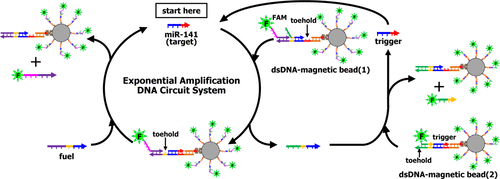Our official English website, www.x-mol.net, welcomes your
feedback! (Note: you will need to create a separate account there.)
Comparative Study of DNA Circuit System-Based Proportional and Exponential Amplification Strategies for Enzyme-Free and Rapid Detection of miRNA at Room Temperature
ACS Omega ( IF 3.7 ) Pub Date : 2018-03-20 00:00:00 , DOI: 10.1021/acsomega.7b01866 Motoi Oishi 1
ACS Omega ( IF 3.7 ) Pub Date : 2018-03-20 00:00:00 , DOI: 10.1021/acsomega.7b01866 Motoi Oishi 1
Affiliation

|
Because circulating microRNAs (miRNAs) have been recognized as a new class of blood-based biomarkers for various diseases, a significant challenge has been the development of point-of-care testing (POCT) systems based on detection of circulating miRNAs directly from serum. A promising approach to POCT systems is considered to be the development of enzyme-free and isothermal detection systems. Here, two types of DNA circuit system based on proportional and exponential amplification strategies were constructed using double-stranded DNA-modified magnetic beads (dsDNA-MBs) and their performances for detection of miRNA were studied comparatively. Both proportional and exponential amplification DNA circuit systems enabled the detection of target miRNA (miR-141) at room temperature without the need for additional enzymes because miR-141 acted as a catalyst for successive toehold-mediated DNA displacement reactions. A significant increase in the noise fluorescence signal was observed for the exponential amplification DNA circuit system because of the leakage (undesired DNA displacement reaction) revealed by the kinetic study on each DNA displacement reaction. Nevertheless, the exponential amplification DNA circuit system showed a lower limit of detection (LOD: 46 pM) and shorter assay time (15 min) compared to those of the proportional amplification DNA circuit system (LOD: 103 pM at 180 min). It is most likely that the exponential amplification DNA circuit system enabled amplification of both the signals and target miR-141, whereas the proportional amplification DNA circuit system enabled amplification of the signals alone. In addition, the exponential amplification DNA circuit system was able to discriminate between mismatched base sequences in miR-200 family members and specifically detect miR-141 even in the presence of serum. These findings are important for the rational design for POCT systems.
中文翻译:

基于 DNA 电路系统的比例和指数扩增策略的比较研究,用于室温下无酶快速检测 miRNA
由于循环 microRNA (miRNA) 已被认为是多种疾病的新型血液生物标志物,因此开发基于直接从血清中检测循环 miRNA 的即时检测 (POCT) 系统是一项重大挑战。 POCT 系统的一种有前途的方法被认为是开发无酶和等温检测系统。本文利用双链DNA修饰磁珠(dsDNA-MBs)构建了两种基于比例和指数扩增策略的DNA电路系统,并比较研究了它们检测miRNA的性能。比例和指数扩增 DNA 电路系统都能够在室温下检测目标 miRNA (miR-141),而不需要额外的酶,因为 miR-141 充当连续立足点介导的 DNA 置换反应的催化剂。由于每个 DNA 置换反应的动力学研究揭示了泄漏(不需要的 DNA 置换反应),指数扩增 DNA 电路系统的噪声荧光信号显着增加。然而,与比例扩增 DNA 电路系统(LOD:180 分钟时 103 pM)相比,指数扩增 DNA 电路系统显示出较低的检测限(LOD:46 pM)和更短的测定时间(15 分钟)。最有可能的是,指数扩增DNA电路系统能够扩增信号和靶标miR-141,而比例扩增DNA电路系统能够单独扩增信号。 此外,指数扩增DNA电路系统能够区分miR-200家族成员中的错配碱基序列,并且即使在存在血清的情况下也能够特异性检测miR-141。这些发现对于 POCT 系统的合理设计非常重要。
更新日期:2018-03-20
中文翻译:

基于 DNA 电路系统的比例和指数扩增策略的比较研究,用于室温下无酶快速检测 miRNA
由于循环 microRNA (miRNA) 已被认为是多种疾病的新型血液生物标志物,因此开发基于直接从血清中检测循环 miRNA 的即时检测 (POCT) 系统是一项重大挑战。 POCT 系统的一种有前途的方法被认为是开发无酶和等温检测系统。本文利用双链DNA修饰磁珠(dsDNA-MBs)构建了两种基于比例和指数扩增策略的DNA电路系统,并比较研究了它们检测miRNA的性能。比例和指数扩增 DNA 电路系统都能够在室温下检测目标 miRNA (miR-141),而不需要额外的酶,因为 miR-141 充当连续立足点介导的 DNA 置换反应的催化剂。由于每个 DNA 置换反应的动力学研究揭示了泄漏(不需要的 DNA 置换反应),指数扩增 DNA 电路系统的噪声荧光信号显着增加。然而,与比例扩增 DNA 电路系统(LOD:180 分钟时 103 pM)相比,指数扩增 DNA 电路系统显示出较低的检测限(LOD:46 pM)和更短的测定时间(15 分钟)。最有可能的是,指数扩增DNA电路系统能够扩增信号和靶标miR-141,而比例扩增DNA电路系统能够单独扩增信号。 此外,指数扩增DNA电路系统能够区分miR-200家族成员中的错配碱基序列,并且即使在存在血清的情况下也能够特异性检测miR-141。这些发现对于 POCT 系统的合理设计非常重要。









































 京公网安备 11010802027423号
京公网安备 11010802027423号